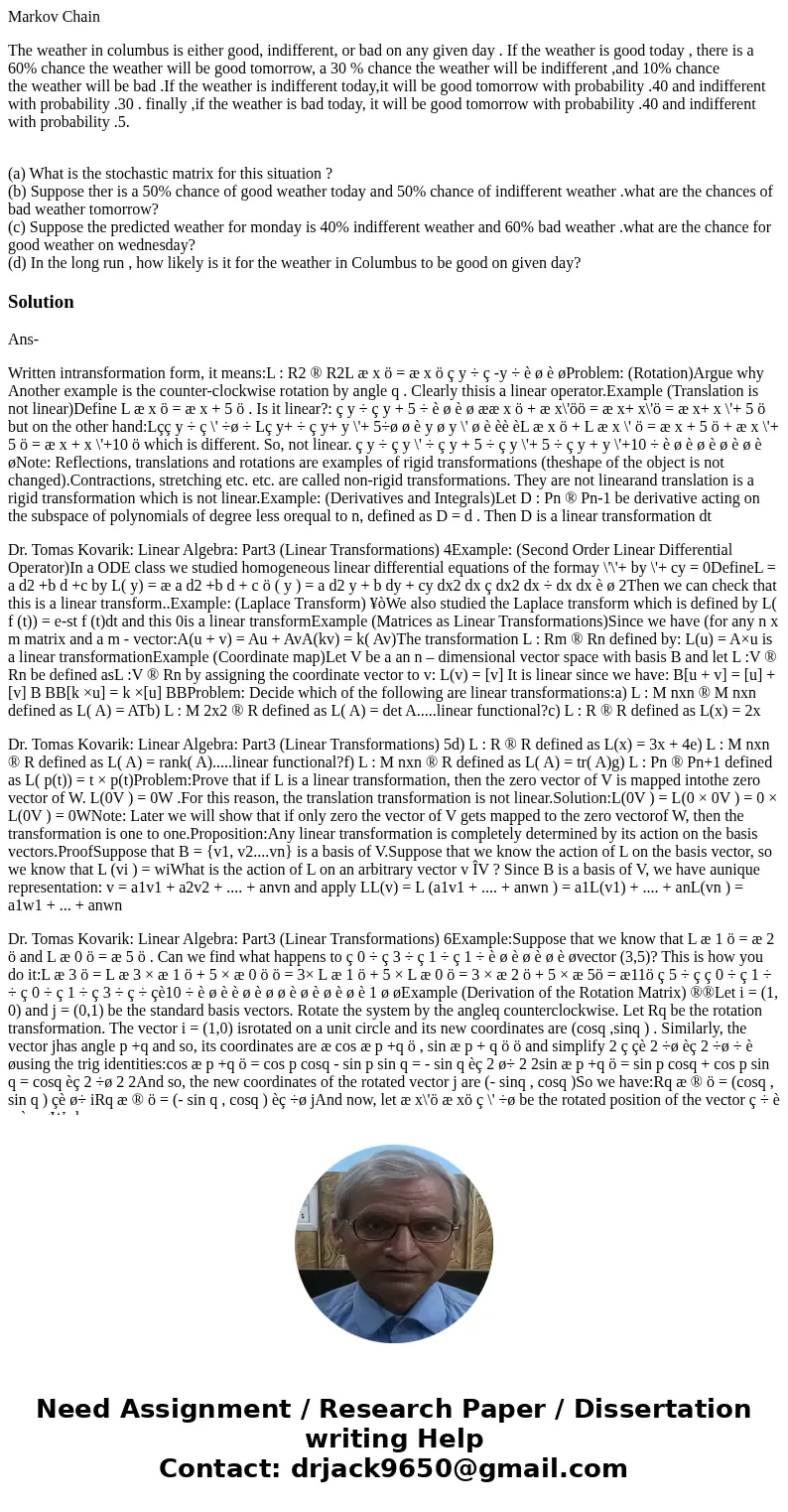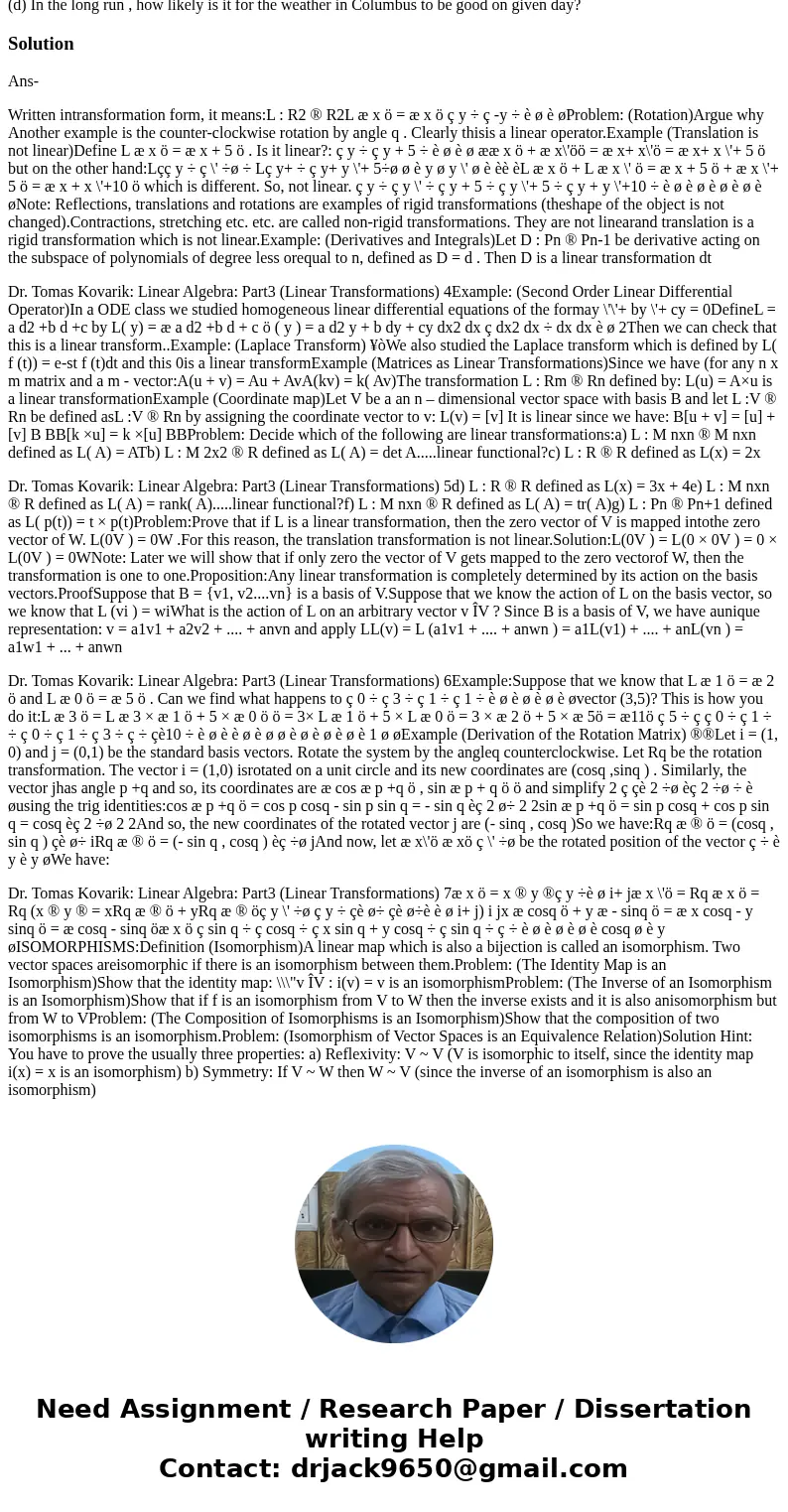Markov Chain The weather in columbus is either good indiffer
Markov Chain
The weather in columbus is either good, indifferent, or bad on any given day . If the weather is good today , there is a 60% chance the weather will be good tomorrow, a 30 % chance the weather will be indifferent ,and 10% chance
the weather will be bad .If the weather is indifferent today,it will be good tomorrow with probability .40 and indifferent with probability .30 . finally ,if the weather is bad today, it will be good tomorrow with probability .40 and indifferent with probability .5.
(a) What is the stochastic matrix for this situation ?
(b) Suppose ther is a 50% chance of good weather today and 50% chance of indifferent weather .what are the chances of bad weather tomorrow?
(c) Suppose the predicted weather for monday is 40% indifferent weather and 60% bad weather .what are the chance for good weather on wednesday?
(d) In the long run , how likely is it for the weather in Columbus to be good on given day?
Solution
Ans-
Written intransformation form, it means:L : R2 ® R2L æ x ö = æ x ö ç y ÷ ç -y ÷ è ø è øProblem: (Rotation)Argue why Another example is the counter-clockwise rotation by angle q . Clearly thisis a linear operator.Example (Translation is not linear)Define L æ x ö = æ x + 5 ö . Is it linear?: ç y ÷ ç y + 5 ÷ è ø è ø ææ x ö + æ x\'öö = æ x+ x\'ö = æ x+ x \'+ 5 ö but on the other hand:Lçç y ÷ ç \' ÷ø ÷ Lç y+ ÷ ç y+ y \'+ 5÷ø ø è y ø y \' ø è èè èL æ x ö + L æ x \' ö = æ x + 5 ö + æ x \'+ 5 ö = æ x + x \'+10 ö which is different. So, not linear. ç y ÷ ç y \' ÷ ç y + 5 ÷ ç y \'+ 5 ÷ ç y + y \'+10 ÷ è ø è ø è ø è ø è øNote: Reflections, translations and rotations are examples of rigid transformations (theshape of the object is not changed).Contractions, stretching etc. etc. are called non-rigid transformations. They are not linearand translation is a rigid transformation which is not linear.Example: (Derivatives and Integrals)Let D : Pn ® Pn-1 be derivative acting on the subspace of polynomials of degree less orequal to n, defined as D = d . Then D is a linear transformation dt
Dr. Tomas Kovarik: Linear Algebra: Part3 (Linear Transformations) 4Example: (Second Order Linear Differential Operator)In a ODE class we studied homogeneous linear differential equations of the formay \'\'+ by \'+ cy = 0DefineL = a d2 +b d +c by L( y) = æ a d2 +b d + c ö ( y ) = a d2 y + b dy + cy dx2 dx ç dx2 dx ÷ dx dx è ø 2Then we can check that this is a linear transform..Example: (Laplace Transform) ¥òWe also studied the Laplace transform which is defined by L( f (t)) = e-st f (t)dt and this 0is a linear transformExample (Matrices as Linear Transformations)Since we have (for any n x m matrix and a m - vector:A(u + v) = Au + AvA(kv) = k( Av)The transformation L : Rm ® Rn defined by: L(u) = A×u is a linear transformationExample (Coordinate map)Let V be a an n – dimensional vector space with basis B and let L :V ® Rn be defined asL :V ® Rn by assigning the coordinate vector to v: L(v) = [v] It is linear since we have: B[u + v] = [u] +[v] B BB[k ×u] = k ×[u] BBProblem: Decide which of the following are linear transformations:a) L : M nxn ® M nxn defined as L( A) = ATb) L : M 2x2 ® R defined as L( A) = det A.....linear functional?c) L : R ® R defined as L(x) = 2x
Dr. Tomas Kovarik: Linear Algebra: Part3 (Linear Transformations) 5d) L : R ® R defined as L(x) = 3x + 4e) L : M nxn ® R defined as L( A) = rank( A).....linear functional?f) L : M nxn ® R defined as L( A) = tr( A)g) L : Pn ® Pn+1 defined as L( p(t)) = t × p(t)Problem:Prove that if L is a linear transformation, then the zero vector of V is mapped intothe zero vector of W. L(0V ) = 0W .For this reason, the translation transformation is not linear.Solution:L(0V ) = L(0 × 0V ) = 0 × L(0V ) = 0WNote: Later we will show that if only zero the vector of V gets mapped to the zero vectorof W, then the transformation is one to one.Proposition:Any linear transformation is completely determined by its action on the basis vectors.ProofSuppose that B = {v1, v2....vn} is a basis of V.Suppose that we know the action of L on the basis vector, so we know that L (vi ) = wiWhat is the action of L on an arbitrary vector v ÎV ? Since B is a basis of V, we have aunique representation: v = a1v1 + a2v2 + .... + anvn and apply LL(v) = L (a1v1 + .... + anwn ) = a1L(v1) + .... + anL(vn ) = a1w1 + ... + anwn
Dr. Tomas Kovarik: Linear Algebra: Part3 (Linear Transformations) 6Example:Suppose that we know that L æ 1 ö = æ 2 ö and L æ 0 ö = æ 5 ö . Can we find what happens to ç 0 ÷ ç 3 ÷ ç 1 ÷ ç 1 ÷ è ø è ø è ø è øvector (3,5)? This is how you do it:L æ 3 ö = L æ 3 × æ 1 ö + 5 × æ 0 ö ö = 3× L æ 1 ö + 5 × L æ 0 ö = 3 × æ 2 ö + 5 × æ 5ö = æ11ö ç 5 ÷ ç ç 0 ÷ ç 1 ÷ ÷ ç 0 ÷ ç 1 ÷ ç 3 ÷ ç ÷ çè10 ÷ è ø è è ø è ø ø è ø è ø è ø è 1 ø øExample (Derivation of the Rotation Matrix) ®®Let i = (1, 0) and j = (0,1) be the standard basis vectors. Rotate the system by the angleq counterclockwise. Let Rq be the rotation transformation. The vector i = (1,0) isrotated on a unit circle and its new coordinates are (cosq ,sinq ) . Similarly, the vector jhas angle p +q and so, its coordinates are æ cos æ p +q ö , sin æ p + q ö ö and simplify 2 ç çè 2 ÷ø èç 2 ÷ø ÷ è øusing the trig identities:cos æ p +q ö = cos p cosq - sin p sin q = - sin q èç 2 ø÷ 2 2sin æ p +q ö = sin p cosq + cos p sin q = cosq èç 2 ÷ø 2 2And so, the new coordinates of the rotated vector j are (- sinq , cosq )So we have:Rq æ ® ö = (cosq , sin q ) çè ø÷ iRq æ ® ö = (- sin q , cosq ) èç ÷ø jAnd now, let æ x\'ö æ xö ç \' ÷ø be the rotated position of the vector ç ÷ è y è y øWe have:
Dr. Tomas Kovarik: Linear Algebra: Part3 (Linear Transformations) 7æ x ö = x ® y ®ç y ÷è ø i+ jæ x \'ö = Rq æ x ö = Rq (x ® y ® = xRq æ ® ö + yRq æ ® öç y \' ÷ø ç y ÷ çè ø÷ çè ø÷è è ø i+ j) i jx æ cosq ö + y æ - sinq ö = æ x cosq - y sinq ö = æ cosq - sinq öæ x ö ç sin q ÷ ç cosq ÷ ç x sin q + y cosq ÷ ç sin q ÷ ç ÷ è ø è ø è ø è cosq ø è y øISOMORPHISMS:Definition (Isomorphism)A linear map which is also a bijection is called an isomorphism. Two vector spaces areisomorphic if there is an isomorphism between them.Problem: (The Identity Map is an Isomorphism)Show that the identity map: \\\"v ÎV : i(v) = v is an isomorphismProblem: (The Inverse of an Isomorphism is an Isomorphism)Show that if f is an isomorphism from V to W then the inverse exists and it is also anisomorphism but from W to VProblem: (The Composition of Isomorphisms is an Isomorphism)Show that the composition of two isomorphisms is an isomorphism.Problem: (Isomorphism of Vector Spaces is an Equivalence Relation)Solution Hint: You have to prove the usually three properties: a) Reflexivity: V ~ V (V is isomorphic to itself, since the identity map i(x) = x is an isomorphism) b) Symmetry: If V ~ W then W ~ V (since the inverse of an isomorphism is also an isomorphism)


 Homework Sourse
Homework Sourse